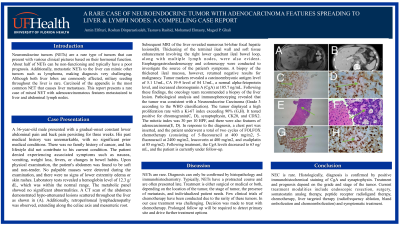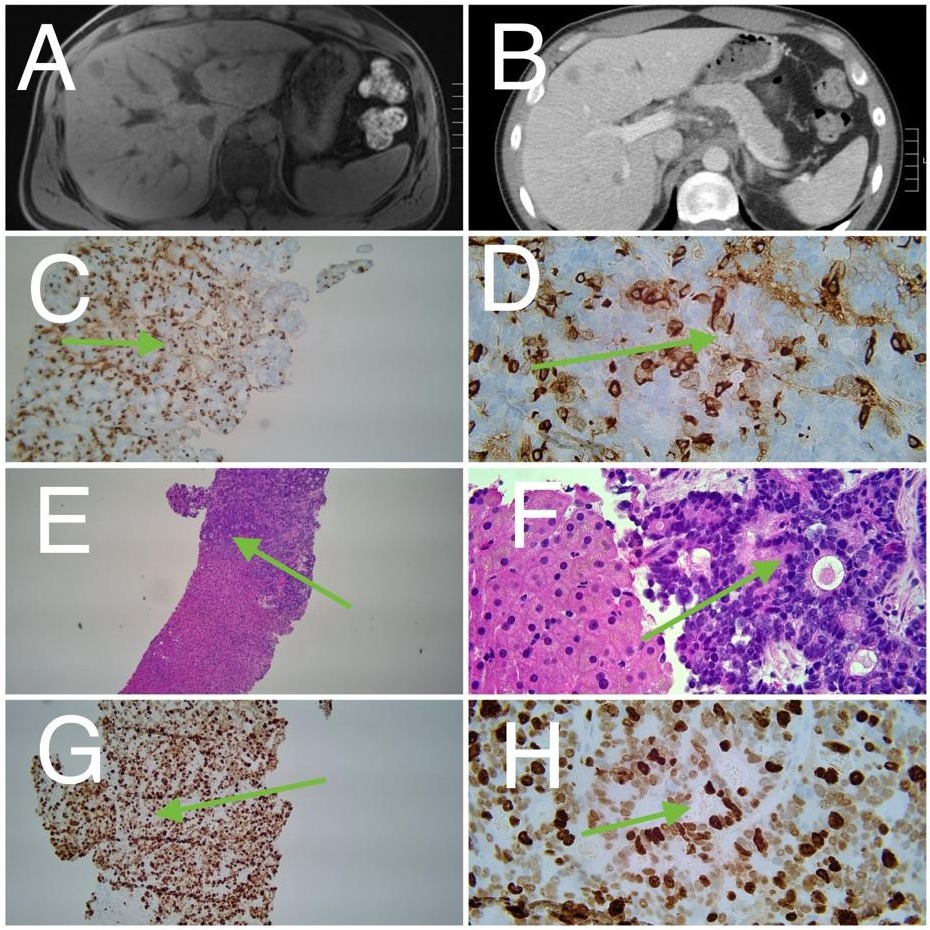Sunday Poster Session
Category: Liver
P1094 - A Rare Case of Adenocarcinoma With Neuroendocrine Features Spreading to Liver and Lymph Nodes: A Compelling Case Report
Sunday, October 22, 2023
3:30 PM - 7:00 PM PT
Location: Exhibit Hall

Has Audio

Amin Elfituri, MD
University of Florida
Jacksonville, FL
Presenting Author(s)
Amin Elfituri, MD1, Roshan Dinparastisaleh, MD1, Tasnuva Rashid, MD1, Mohamed Elmasry, DO2, Maged P. Ghali, MD1
1University of Florida, Jacksonville, FL; 2University of Florida College of Medicine Jacksonville, Jacksonville, FL
Introduction: Neuroendocrine tumors are a rare type of tumors that can present with various clinical pictures based on their hormonal function. About half of NETs can be non-functioning and typically have a poor prognosis. Additionally, metastatic NETs to the liver can mimic other tumors such as lymphoma, making diagnosis very challenging. Although both liver lobes are commonly affected, miliary seeding throughout the liver is rare. Carcinoid of the appendix is the most common NET that causes liver metastases. This report presents a rare case of mixed NET with adenocarcinomatous features metastasized to liver and abdominal lymph nodes.
Case Description/Methods: A 36-year-old male presented with lower abdominal pain and back pain for three weeks. On physical exam, the abdomen was soft and non-tender, and no lower extremity edema or skin rashes. Laboratory tests showed hemoglobin of 12.3 g, platelets of 213 thousand/uL, and creatinine of 1.00 mg/dL. Tumor markers revealed carcinoembryonic antigen of 5.1 U/mL, CA 19-9 of 84 U/mL, with normal alpha-fetoprotein. Chromogranin A was 105.7 ng/L. CT of the abdomen revealed hypo-attenuated lesions throughout the liver, as well as retroperitoneal lymphadenopathy extending along the celiac axis and mesenteric root. MRI of the liver showed innumerable bi-lobar focal hepatic lesions, bowel wall thickening, and soft tissue enhancement involving the right lower quadrant ileal bowel loop with numerous lymph nodes. Oncology team recommended a biopsy of the liver lesion. Pathology and immunophenotype were consistent with aggressive NET with Ki-67 > 90%, positive for chromogranin, synaptophysin, CK20, CDX2 with features of adenocarcinoma. Esophagogastroduodenoscopy and colonoscopy completed and biopsy of thickened mucosa was negative for malignancy. A chest port was inserted, and the patient received a total of two cycles of FOLFOX (5FU 400mg/m2, 5FU 2400mg/m2, Leucovorin 400mg/m2, Oxaliplatin 85mg/m2).
Discussion: NETs are rare . Few clinical trials of chemotherapy have been conducted due to the rarity of these tumors. Diagnosis can only be confirmed by histopathology and immunohistochemistry. Typically, NETs have a protracted course and are often presented late. Treatment is either surgical or medical or both, depending on the location of the tumor and the presence of metastasis. In our case treatment was challenging, decision was made by clinicians to treat with chemotherapy. Prolonged follow up will be required to detect primary site and drive further treatment options.

Disclosures:
Amin Elfituri, MD1, Roshan Dinparastisaleh, MD1, Tasnuva Rashid, MD1, Mohamed Elmasry, DO2, Maged P. Ghali, MD1. P1094 - A Rare Case of Adenocarcinoma With Neuroendocrine Features Spreading to Liver and Lymph Nodes: A Compelling Case Report, ACG 2023 Annual Scientific Meeting Abstracts. Vancouver, BC, Canada: American College of Gastroenterology.
1University of Florida, Jacksonville, FL; 2University of Florida College of Medicine Jacksonville, Jacksonville, FL
Introduction: Neuroendocrine tumors are a rare type of tumors that can present with various clinical pictures based on their hormonal function. About half of NETs can be non-functioning and typically have a poor prognosis. Additionally, metastatic NETs to the liver can mimic other tumors such as lymphoma, making diagnosis very challenging. Although both liver lobes are commonly affected, miliary seeding throughout the liver is rare. Carcinoid of the appendix is the most common NET that causes liver metastases. This report presents a rare case of mixed NET with adenocarcinomatous features metastasized to liver and abdominal lymph nodes.
Case Description/Methods: A 36-year-old male presented with lower abdominal pain and back pain for three weeks. On physical exam, the abdomen was soft and non-tender, and no lower extremity edema or skin rashes. Laboratory tests showed hemoglobin of 12.3 g, platelets of 213 thousand/uL, and creatinine of 1.00 mg/dL. Tumor markers revealed carcinoembryonic antigen of 5.1 U/mL, CA 19-9 of 84 U/mL, with normal alpha-fetoprotein. Chromogranin A was 105.7 ng/L. CT of the abdomen revealed hypo-attenuated lesions throughout the liver, as well as retroperitoneal lymphadenopathy extending along the celiac axis and mesenteric root. MRI of the liver showed innumerable bi-lobar focal hepatic lesions, bowel wall thickening, and soft tissue enhancement involving the right lower quadrant ileal bowel loop with numerous lymph nodes. Oncology team recommended a biopsy of the liver lesion. Pathology and immunophenotype were consistent with aggressive NET with Ki-67 > 90%, positive for chromogranin, synaptophysin, CK20, CDX2 with features of adenocarcinoma. Esophagogastroduodenoscopy and colonoscopy completed and biopsy of thickened mucosa was negative for malignancy. A chest port was inserted, and the patient received a total of two cycles of FOLFOX (5FU 400mg/m2, 5FU 2400mg/m2, Leucovorin 400mg/m2, Oxaliplatin 85mg/m2).
Discussion: NETs are rare . Few clinical trials of chemotherapy have been conducted due to the rarity of these tumors. Diagnosis can only be confirmed by histopathology and immunohistochemistry. Typically, NETs have a protracted course and are often presented late. Treatment is either surgical or medical or both, depending on the location of the tumor and the presence of metastasis. In our case treatment was challenging, decision was made by clinicians to treat with chemotherapy. Prolonged follow up will be required to detect primary site and drive further treatment options.

Figure: Images(MRI, CT), Immunohistochemistry(Ki67, chromogranin, H&E indicating by green marker) of rare metastatic liver cancer with neuroendocrine features.
| Tumor Markers | Result |
| Alpha Feto Prot | < 1.8 |
| CA 19-9 | 84 |
| CEA | 5.1 |
| Chromogranin A | 105.7 |
Table: Results of Malignant tumor markers.
Disclosures:
Amin Elfituri indicated no relevant financial relationships.
Roshan Dinparastisaleh indicated no relevant financial relationships.
Tasnuva Rashid indicated no relevant financial relationships.
Mohamed Elmasry indicated no relevant financial relationships.
Maged Ghali indicated no relevant financial relationships.
Amin Elfituri, MD1, Roshan Dinparastisaleh, MD1, Tasnuva Rashid, MD1, Mohamed Elmasry, DO2, Maged P. Ghali, MD1. P1094 - A Rare Case of Adenocarcinoma With Neuroendocrine Features Spreading to Liver and Lymph Nodes: A Compelling Case Report, ACG 2023 Annual Scientific Meeting Abstracts. Vancouver, BC, Canada: American College of Gastroenterology.
